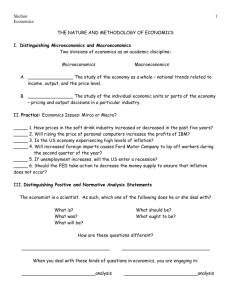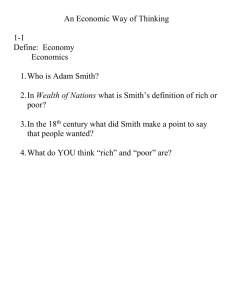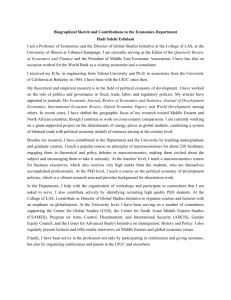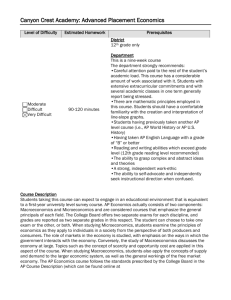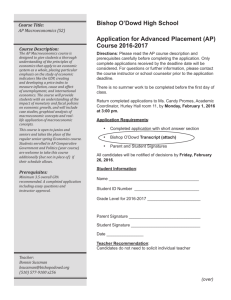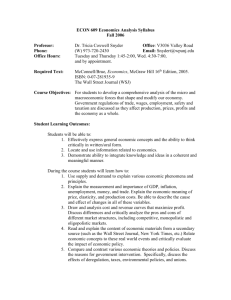Course Title: AP Economics - Ms. Kirsch
advertisement
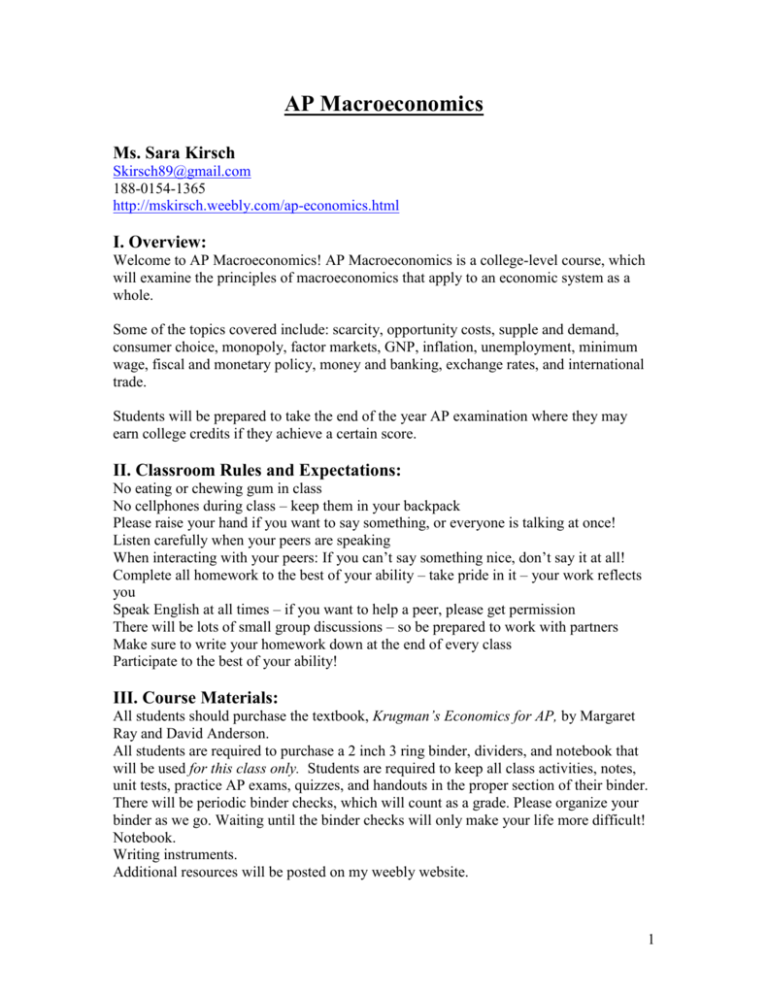
AP Macroeconomics Ms. Sara Kirsch Skirsch89@gmail.com 188-0154-1365 http://mskirsch.weebly.com/ap-economics.html I. Overview: Welcome to AP Macroeconomics! AP Macroeconomics is a college-level course, which will examine the principles of macroeconomics that apply to an economic system as a whole. Some of the topics covered include: scarcity, opportunity costs, supple and demand, consumer choice, monopoly, factor markets, GNP, inflation, unemployment, minimum wage, fiscal and monetary policy, money and banking, exchange rates, and international trade. Students will be prepared to take the end of the year AP examination where they may earn college credits if they achieve a certain score. II. Classroom Rules and Expectations: No eating or chewing gum in class No cellphones during class – keep them in your backpack Please raise your hand if you want to say something, or everyone is talking at once! Listen carefully when your peers are speaking When interacting with your peers: If you can’t say something nice, don’t say it at all! Complete all homework to the best of your ability – take pride in it – your work reflects you Speak English at all times – if you want to help a peer, please get permission There will be lots of small group discussions – so be prepared to work with partners Make sure to write your homework down at the end of every class Participate to the best of your ability! III. Course Materials: All students should purchase the textbook, Krugman’s Economics for AP, by Margaret Ray and David Anderson. All students are required to purchase a 2 inch 3 ring binder, dividers, and notebook that will be used for this class only. Students are required to keep all class activities, notes, unit tests, practice AP exams, quizzes, and handouts in the proper section of their binder. There will be periodic binder checks, which will count as a grade. Please organize your binder as we go. Waiting until the binder checks will only make your life more difficult! Notebook. Writing instruments. Additional resources will be posted on my weebly website. 1 IV. Instructional Resources: Textbook: Krugman’s Economics for AP, Margaret Ray and David Anderson Supplementary Materials: 1. www.reffonomics.com 2. www.fte.org 3. U.S. Trade Policy: Competing in a Global Economy 4. Dilemmas of Foreign Aid: Debating U.S. Priorities, Policies and Practices 5. Advanced Macroeconomics, John Morton 6. Selected articles from The Economist, Business Weekly, Money Magazine, The Wall Street Journal, New York Times Upfront (weekly current issues periodical) and Current Events (weekly current issues periodical). Additional Materials: 1. “The Debt Game,” American Friends Service Committee (simulation) 2. “The Invisible Hand Simulation,” Focus: High School Economics 3. “Wheat Market Simulation,” Focus: High School Economics 4. “Business Productivity Simulation,” Focus: High School Economics 5. “Collective Bargaining Simulation,” Focus: High School Economics 6. “Monetary Policy Simulations,” Focus: High School Economics 7. “Inflation Simulation” 8. “Stock Market Pit Simulation” 9. “Bead Game Simulation,” Focus: High School Economics 10. “Comparative Trade Simulation” 11. “Individual Investment Simulation” Technology: **Online Resources 1. A+ Country Reports 2. DiscoverEcon 3. Library of Congress Country Studies 4. Federal Reserve Education 5. The College Board Video Resources: 1. 2. 3. 4. 5. 6. “Roger & Me” “The Commanding Heights” “Chinese Capitalism” “Inside the Federal Reserve (interactive video)” “Modern Marvels: The Stock Market” “Understanding Economics” 2 7. “Economics in a Changing World: Where do I fit in?” 8. “International Trade” 9. “The Big One (Michael Moore Documentary)” 10. “Freeloader (ABC News Video with John Stossel)” 11. “Is America Number One (ABC News Video with John Stossel)” 12. “Freakonomics” 13. “Macroeconomics, Government and International Trade (ABC News Video with John Stossel)” Practice AP Exams from the College Board V: Units of Study A. Fundamental Macroeconomics Concepts – Scarcity, Trade, Supply and Demand 1. What are the major components of macroeconomics? 2. What is the importance of inflation, unemployment, and interest rate? 3. What is a public good? How do we allocate such resources? 4. What is an externality? How do we control such items? B. Measurements of Economic Performance 1. How do we measure the economy? What is the importance of these measures? 2. What are GNP and GDP? What do these numbers tell us bout the economy? 3. How is the unemployment rate measured and why can we have a positive unemployment rate when there is so-called ‘full’ employment? 4. What is the distinction between nominal and real values? C. National Income and Price Determination 1. How is aggregate supply affected in a short-run and long-run analysis? 2. What do we mean by “supply–side” policies? 3. What are the components of aggregate demand? 4. What does a Phillips curve tell us about the inflation-unemployment trade-off and how this trade-off may differ in the short and long run? D. Economic Growth 1. How does economic growth contribute to job creation and economic well-being? 2. What is a business cycle? 3. What causes constriction and expansion? 4. How do changes in monetary and fiscal policy affect the growth of a nation’s economy? E. International Finance, Exchange Rates, and Balance of Payments 3 1. 2. 3. 4. 5. What is the government’s role in international trade? What is meant by a comparative advantage? Absolute advantage? How does international finance affect our economy? What are the effects of a trade deficit? How does international trade affect the business cycle? IV. Assessment Methods: Essays/Position Papers Online Discussion Forums (Weebly Website) Tests and quizzes Simulations Panel Discussions Class Debates Problem solving exercises Creative projects Binder Checks (Notes including vocabulary and in class activities will be checked) Multimedia presentations (including PowerPoint) 4


